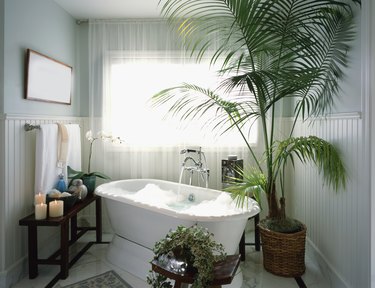
Houseplants need regular fertilizing since they can't get any extra nutrients unless you are the one to provide it. Urea fertilizer can be used on indoor plants, but it may not be the best fertilizer option for all plant species. If urea is an option for your indoor greenery, following specific dilution and application processes helps you use it safely.
What Is Urea?
Video of the Day
Urea is a naturally occurring substance that has a high nitrogen count. In the usual fertilizer ratio of nitrogen, phosphorus and potassium, urea is 46-0-0. All plants need nitrogen, which helps with the formation of green leafy growth and protein formation and drives the production of chlorophyll.
Video of the Day
Nitrogen is ever present in the air but plants aren't able to harvest the nitrogen from the atmosphere. Urea acts very quickly on plants and contains large amounts of salts. Salts can build up in potted soils and can eventually poison the plant, so it's important to use the fertilizer properly to avoid issues.
Know Your Plant
The best fertilizer for houseplants isn't the same for every plant, since each has its own needs. Not every houseplant is a heavy nitrogen user, which means it may not need the addition of nitrogen. Potting mixes and fertilizers often have urea with ammonium sulfate incorporated into them, which slows the release of the urea. This provides enough nitrogen for most potted plants as long as they are re-potted every few years.
Bamboo, potted roses and orchids are commonly fertilized with urea. Other plants may be sensitive to such a high formulation, so it's a good idea to consult a nursery professional or extension horticulturist regarding the nitrogen needs of your particular plant. An example is the African violet (Streptocarpus ionanthus, formerly Saintpaulia ionantha, USDA zones 11-12). This plant is sensitive to urea, which can burn its roots.
Urea Effects in Soil
Urea turns into ammonia with air exposure within a short period of time. For this reason, it's mixed into soil or applied as a drench so the solution seeps in before it become toxic. Urea becomes a nitrate when it's mixed in soil and contacts water. Within a few hours of application, foliage is noticeably greener.
Urea contains high amounts of sodium, which act upon a plant hydration system much like it does in humans. You can prevent sodium buildup in the soil by soaking the plant until water pours out of the drainage holes. This will flush out any excess salts and clear the soil.
Application on Potted Indoor Plants
Since indoor plants are almost always potted, they can only get their required nutrients from the limited area of the soil. They don't have the advantage that outdoor plants have, where extra organic matter is constantly layered into the soil to provide more nutrients. Potted plants should usually be fertilized annually.
Urea is a component of a strong acid, uric acid, and is still slightly caustic even after processing. Urea should be diluted to at least half distillation, and the soils should be well watered after application when used as indoor plant fertilizer. A good use of urea is in foliar sprays, where the plant can immediately use what it needs and the rest evaporates.
Types of Urea Fertilizer
There are a few different formulations of urea for plants, each of which has a different release rate. Straight urea is not commonly used in potted plants. It provides the highest level of nitrogen and is quickly broken down, often within two days.
Urea formaldehyde has only about 38 percent nitrogen and decomposes with the assistance of micro-organisms and is slower to release in winter. Isobutylidene diurea only provides 31 percent nitrogen and releases urea slowly as it dissolves. It's only slightly soluble in water, so the process takes longer than the other formulations. The best formulation for potted indoor plants is crotonylidene diurea, which is a long-term, slow-release formulation.